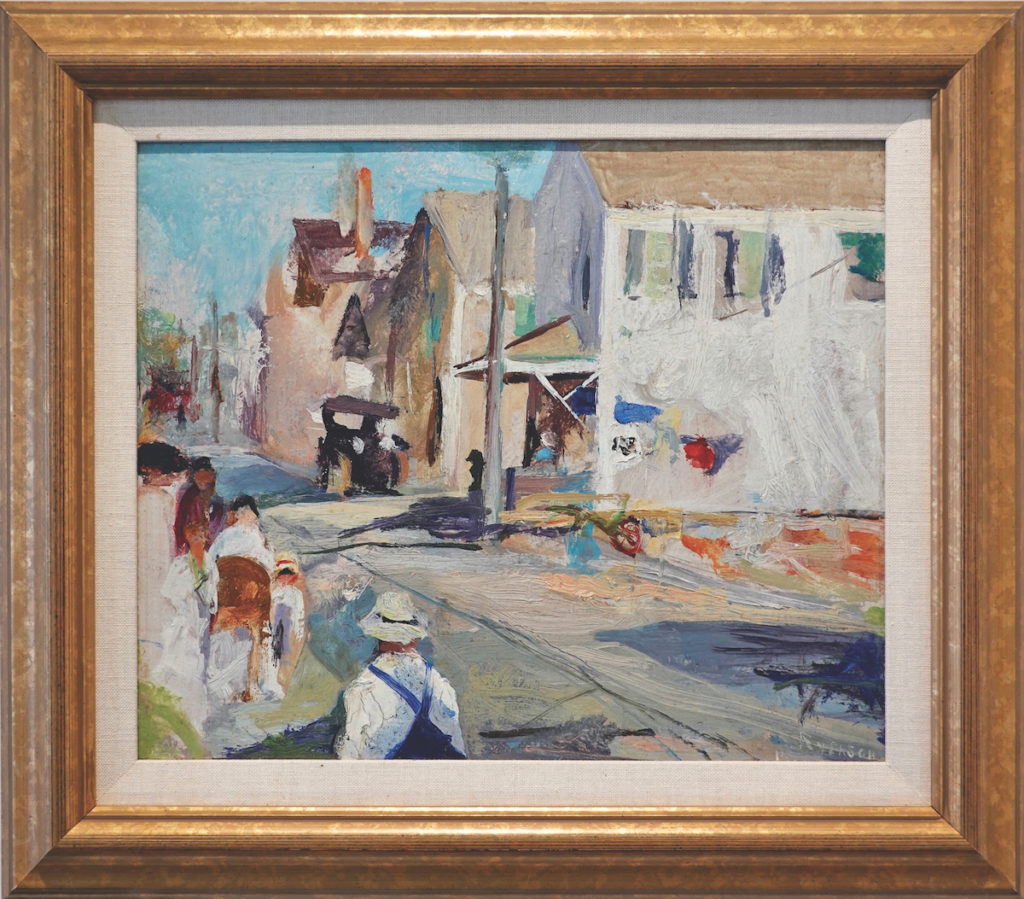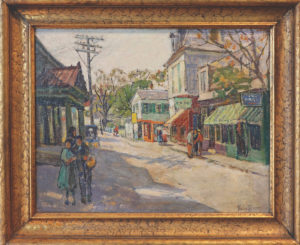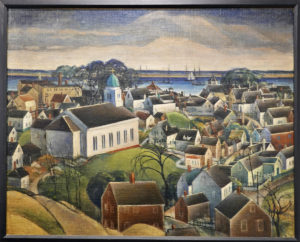
An exhibition of artworks from the collection of Napi and Helen Van Dereck opened last Friday at the Provincetown Art Association and Museum. The first installment of this show took place in March of last year, a few months after Napi, the beloved restaurateur and art collector, died. Because of the Covid lockdown, the exhibit was viewable only online before opening to the public for the summer.
This second installment (“Part II”) proves that Napi’s extensive collection of classic Provincetown art, which is on extended loan to the museum, is far from exhausted. It’s full of gems by Ross Moffett, George Yater, and others. But most notable is the representation of women artists.
Out of 32 artworks, 10 are by women. That’s not equal representation, but it’s pretty good, especially considering that much of the work dates from the early 20th century. The exhibition last March was even better in this regard — about half of the works were by women artists.
In the introduction to last March’s show, curator and PAAM CEO Christine McCarthy wrote that Napi was a “champion of women artists.” She also conferred with James Bakker, a local art dealer, historian, and PAAM board member, who is a strong advocate for the women artists who have been largely absent from the Provincetown art colony historical narrative.

One small disappointment, however, is that the extraordinary Blanche Lazzell, though mentioned in the introduction, is not included in Part II.
Margery Austen Ryerson’s Commercial Street, Provincetown, dated 1911, is small and easy to miss but a highlight of the exhibit. Ryerson lived to be 102 — she even witnessed her centennial show, according to a catalogue by Avis Berman — but she was only in her mid 20s when she painted Commercial Street.
She studied with Charles Webster Hawthorne in Provincetown in the summers from 1911 to 1920. She was, clearly, a good student — Hawthorne’s influence can be seen in the way that the headlights of a vintage automobile are suggested with two swirls of white. A gentleman’s overalls are rendered with two crisscrossed strokes of blue. Ryerson used a lot of paint — evidenced in the way the painting has caked and cracked — and loose, fluid brushstrokes.
Ryerson’s notebooks were the source for the majority of the art text Hawthorne on Painting, which she edited. In New York City, she studied with Robert Henri — she compiled his book The Art Spirit — and painted children in settlement houses.
Though the subjects and vantage point of Ryerson’s Commercial Street and Street Scene, Provincetown, by Pauline Palmer, are nearly identical, the two paintings couldn’t be more different. Palmer was a Chicago-based artist who studied with William Merritt Chase, then came to Provincetown to study with Hawthorne, one of Chase’s students.
She won numerous awards throughout her life. “Palmer was often one of the few women to serve on exhibition juries that were still largely dominated by male artists,” writes Ruth L. Bohan as part of the Illinois Historical Art Project.
Despite the growing dominance of modernism, Palmer maintained a conservative style as long as she painted. In Street Scene, she outlines buildings, trees, and figures in black. One can almost make out the colorful signs outside the striped storefront awnings.
Another interesting backstory from the exhibit is that of Alice Y. Hirsh, who painted Untitled (Pier at Low Tide), a rather unassuming oil on panel from 1916. The tall pilings are reflected in the pale blue water, as are the two people sitting on the pier. The impressionist influence is manifest.

Hirsch studied at the Art Students League of New York. By 1917, she had established her own studio at 51 West 10th St., in Greenwich Village. “She directly marketed her own works from this location and through shows,” which was “quite uncommon,” according to the exhibition label.
The focal points of the Napi show, however, are four paintings from the 1920s by Nancy Maybin Ferguson: East End View, West End Looking Southwest from St. Peter’s, and two untitled oils of the Wren Tower and North Truro Center.
Ferguson, a member of the “Philadelphia Ten,” a group of women artists who showed together, also studied with Hawthorne and Chase.
These bird’s-eye views, slightly oblique, are reminiscent of old map prints, such as Jacopo de’ Barbari’s View of Venice. Indeed, there is something Italian about West End Looking Southwest — St. Peter the Apostle Church, captured here before it was rebuilt after a 2005 fire, could almost be a Renaissance chiesa.
Classic Provincetown
The event: “The Napi and Helen Van Dereck Collection: Part II”
The time: Hourlong time slots from Thursday through Sunday, noon to 5 p.m. Space is limited; reservations at paam.org/tickets
The place: Provincetown Art Association and Museum, 460 Commercial St.
The cost: Museum admission is $12.50; members free



